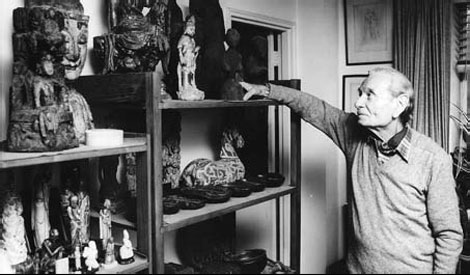
 'Taken 2' grabs movie box office crown
'Taken 2' grabs movie box office crown
 Rihanna's 'Diamonds' tops UK pop chart
Rihanna's 'Diamonds' tops UK pop chart
 Fans get look at vintage Rolling Stones
Fans get look at vintage Rolling Stones
 Celebrities attend Power of Women event
Celebrities attend Power of Women event
 Ang Lee breaks 'every rule' to make unlikely new Life of Pi film
Ang Lee breaks 'every rule' to make unlikely new Life of Pi film
 Rihanna almost thrown out of nightclub
Rihanna almost thrown out of nightclub
 'Dark Knight' wins weekend box office
'Dark Knight' wins weekend box office
 'Total Recall' stars gather in Beverly Hills
'Total Recall' stars gather in Beverly Hills
Mr Miniature's massive collection
Updated: 2013-04-01 05:47
By Kelly Chung Dawson in New York (China Daily)
|
||||||||
|
US collector and scholar Paul Singer (1904-97) once packed 5,000 relics into his small apartment. Provided to China Daily |
Meticulously organized and filled from floor to ceiling, Paul Singer's modest two-bedroom apartment in New Jersey for several decades held a small museum of more than 5,000 Chinese art objects, until the self-taught collector's death in 1997.
A selection of those works is now on display in One Man's Search for Ancient China: The Paul Singer Collection at the Arthur M. Sackler Gallery in the Smithsonian's Museums of Asian Art in Washington.
A psychiatrist by trade, Singer's love of Asian culture and material art was sparked by a childhood visit to a museum in Vienna. That passion was later abetted by a friendship with Arthur M. Sackler, who from the 1970s onward provided Singer with financial support, with the understanding that the collection would eventually be donated to the Sackler Gallery.
"Even though Dr Singer wasn't a trained Sinologist, he was a scholarly collector with a great interest in scholarship on ancient China and a serious student of Chinese archeology," says J. Keith Wilson, curator of ancient Chinese art at the Sackler Gallery.
"During the time he was collecting, Chinese archeology was beginning to mature and this was a vicarious participation on his part in Chinese exploration and discovery of the past. Chinese material culture is probably the richest and most continuous on earth, and that very much interested him."
On display in the exhibit are 63 works, including bronzes, decorative gold fragments and jewelry, ceramics, weaponry and a variety of the small-scale vessels and figurines that gave Singer his nickname - "Mr Miniature".
Some of the pieces in the collection of 5,000 were previously exhibited in 1999.
According to people who visited Singer's small apartment in Summit, New Jersey, the objects were so well organized that he could find a single item within seconds. Wilson says: "His living room became a three-dimensional matrix of Chinese art history."
Singer was extremely devoted to the sharing of scholarship about Chinese material art. He regularly opened up his apartment to visiting scholars and used the apartment as a teaching laboratory, Wilson says.
"You get all sorts of interesting characteristics and personalities with collectors, but what makes Singer stand out is the modesty of his lifestyle and the fact that he made the collection so widely available to specialists and students."
The collector's focus on small-scale objects has made his collection extremely important in the study of Chinese art history, Wilson says.
Singer's focus on this category in Chinese art was in some ways a necessity borne of limited funds and the small size of his apartment.
In the early years, he scoured thrift shops and lower-end stores but branched into higher-stratum objects of a wider variety after Sackler began funding the collection, Wilson says.
"Typically, museums don't collect miniatures, because they figure, why show a small example of something when you can show a big example? But miniatures do represent an important sector of Chinese art history, and the fact that he was drawn to them and acquired so many has filled many of the gaps in this area of Chinese art history that most museums don't show," Wilson says.
Daisy Yiyou Wang, a project specialist in Chinese art who has also studied the history of art collecting, says: "From a collecting point of view, it's a very interesting story.
"Additionally, the collection can teach people a lot about Chinese history and archeology, and it filled many gaps in our own knowledge. Many of the pieces are not only of great archeological importance, they are also visually stunning."
kdawson@chinadailyusa.com
(China Daily 04/01/2013 page20)
Most Viewed
Editor's Picks

|

|

|

|

|

|
Today's Top News
Boston bombing suspect reported cornered on boat
7.0-magnitude quake hits Sichuan
Cross-talk artist helps to spread the word
'Green' awareness levels drop in Beijing
Palace Museum spruces up
First couple on Time's list of most influential
H7N9 flu transmission studied
Trading channels 'need to broaden'
US Weekly

|

|








